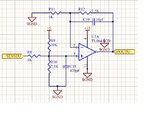giovanni82
Newbie level 1

- Joined
- Sep 25, 2014
- Messages
- 1
- Helped
- 0
- Reputation
- 0
- Reaction score
- 0
- Trophy points
- 1
- Activity points
- 12
Hello guys
this is my first post so I' ll keep it simple
I' m working with the TI TL064 (see the attached schematic) but in stand-by (when SENSEU is 0V) i get an output voltage of 1.3V instead of 2.65V ( that is what i'm expecting).
This is a simple non inverting opamp but i don't understand what i'm missing...
Any suggestion? is the TL064 not the right part to do the job or is there something wrong in my circuit?
Thank you very much
this is my first post so I' ll keep it simple
I' m working with the TI TL064 (see the attached schematic) but in stand-by (when SENSEU is 0V) i get an output voltage of 1.3V instead of 2.65V ( that is what i'm expecting).
This is a simple non inverting opamp but i don't understand what i'm missing...
Any suggestion? is the TL064 not the right part to do the job or is there something wrong in my circuit?
Thank you very much




